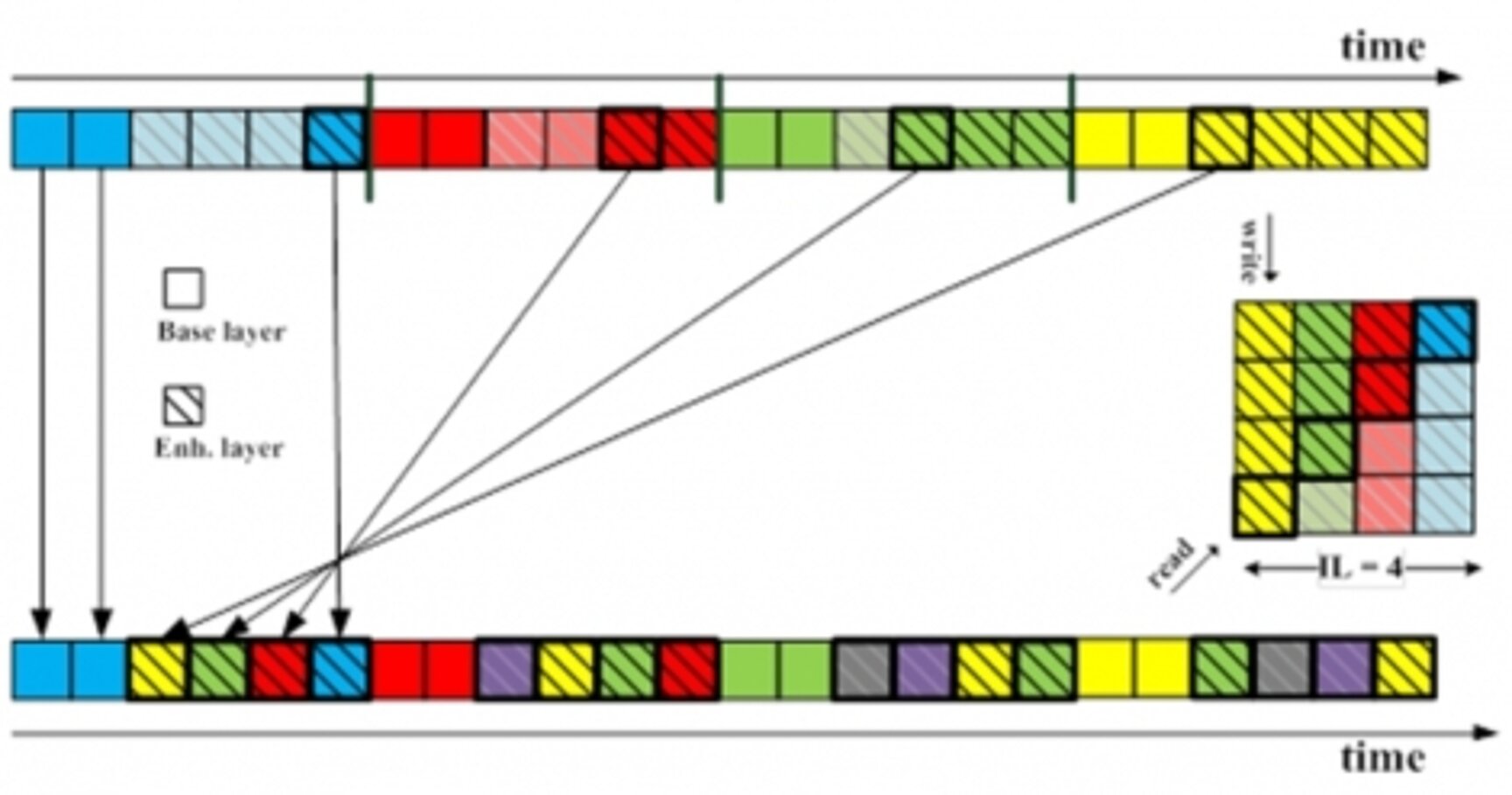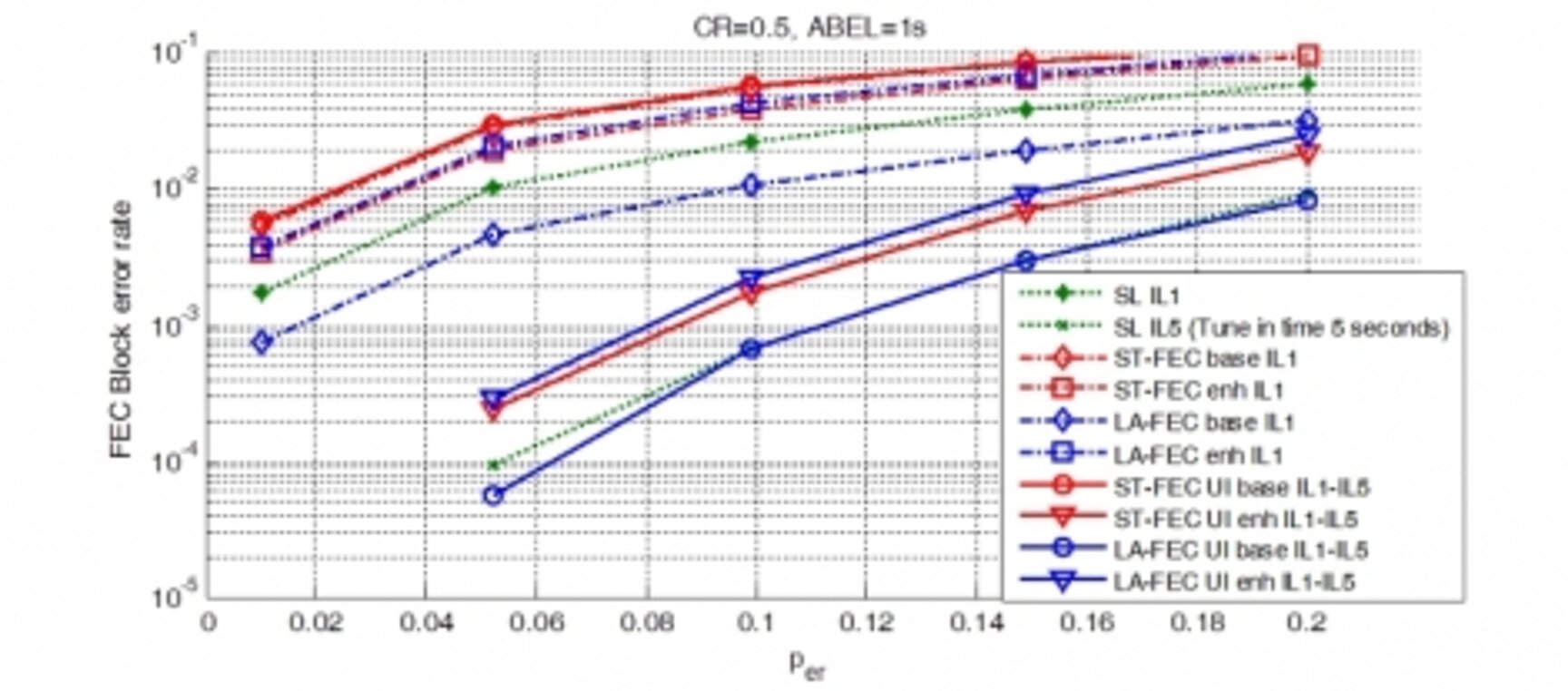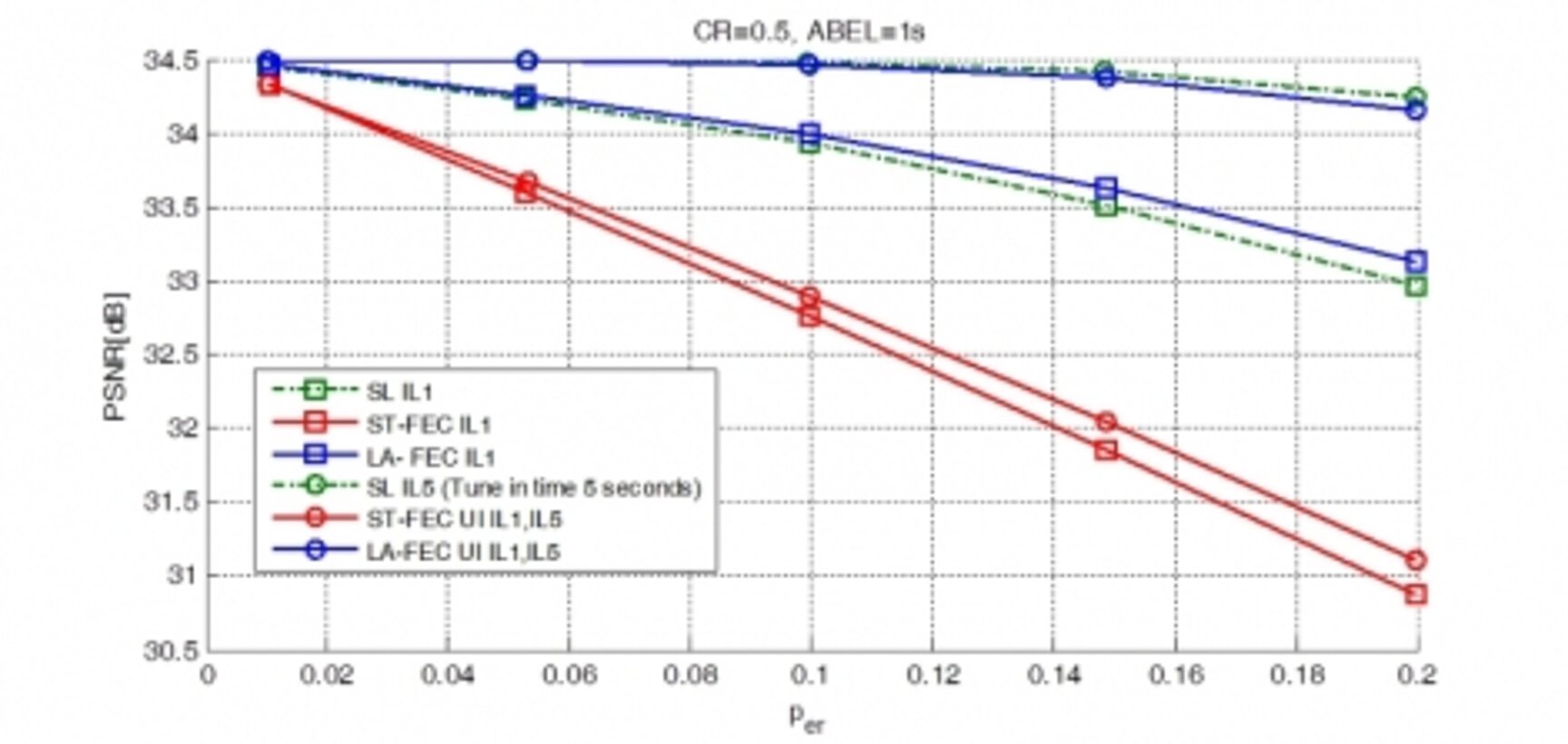LA-FEC UI presents an Application-Layer FEC scheme that marries fast zapping and longtime interleaving by combining Layer-Aware FEC and layered media codecs with unequal time interleaving and an appropriate transmission scheduling. This enables the provisioning of Mobile TV services which are able to overcome long error bursts but still offer users a fast access to the service.
LA-FEC UI
The combination of Layer-Aware FEC and layered media like SVC and MVC enables a new way of service provisioning that marries fast zapping and longtime interleaving.
The fast zapping is given with a lower quality base layer (BL) and a short time interleaving with low robustness against burst errors but low delay. Long time interleaving is provided by the SVC enhancement layer (EL) with stronger robustness against burst losses but increased FEC latency. However, due to the enhancement layer is FEC coded with Layer-Aware FEC across the base layer, the base layer also benefits from the improved time diversity of the enhancement layer.
This scheme is in the following referred to as Unequal time interleaving with LA-FEC or LA-FEC UI. It is important to note that LA-FEC UI can not only be applied to SVC or any other kind of layered media, but also to any kind of time synchronized data. E.g. a possible application would also be to have an audio stream with short time interleaving and a video stream what provides long time interleaving which are connected by LA-FEC.
The tune in time (zapping time) of such a service depends on short interleaving length of the base layer (e.g. 1s). After a transition time (e.g. 3s) the user can tune in to the enhancement layer quality. The transition time depends on the difference in interleaving length between base and enhancement layer, which constitutes the maximum time, and the actual error state of the transmission. Note that in error free case, the transition time can be very close to the tune in time.
The process of unequal stream interleaving with LA-FEC UI is shown in Figure 1.

The example uses an exemplary SVC stream with two layers, which are encoded with Layer-Aware Raptor FEC (see [1]). Each BL (white blocks) FEC source block consists of n0=2 symbols with k0=1 source and p0=1 parity symbols. The EL (gray blocks) has a higher service bit-rate and consists of n1=4 symbols with k1=2 source symbols and p1=2 parity symbols. The number within each symbol denotes the corresponding FEC source block. The protection period of each FEC source block covers one second of the media stream. In the outlined example in Figure 1, the BL is not interleaved with IL0=1 while the EL is interleaved with other FEC source blocks with IL1=4. The illustrated interleaving process works on FEC symbols of fixed size. It is important to note here that the interleaving process can also be performed on packet level like e.g. UDP packets containing the encoded FEC source and parity symbols.
Simulations
This section shows the performance of the LA-FEC UI (LA-FEC) scheme in comparison with standard FEC schemes (ST-FEC) and single layer transmission (SL). The simulations are based on real encoded video streams, which are encapsulated within RTP/UDP/IP protocols. As FEC scheme we assume the Layer-Aware Raptor code [1]. As a transmission channel we use a Gilbert-Elliot model with parameters taken from simulation conditions defined in MPEG [2]. The performance is shown with respect to the FEC performance in terms of FEC block error rate and with respect to the resulting video quality in terms of PSNR. The presented results have been accepted for publication in [3].
Media stream, FEC, and interleaving
All video streams have been encoded with the JSVM reference software. The SL stream has been encoded at QVGA and 30fps using the High Profile at 570 kbps with GOPsize of eight frames and a Random Access Point (RAP) frequency of one per second. The SVC stream is encoded with coarse grain scalability (CGS) at the same resolution and frame-rate using the Scalable High Profile of H.264/AVC. The overall SVC stream shows a coding penalty compared to the SL stream of 10 %, which results in an overall bit-rate of 627 kbps. The largest share with 70 % of the overall bit-rate is allocated in the EL, while the remaining 30 % is allocated in the BL stream. The average video quality of the SL and SVC stream is 34.5 dB in terms of PSNR and the SVC BL quality is 31.0 dB. The network abstraction units (NALUs) of the video stream are encapsulated into the RTP protocol with a target maximum transmission unit (MTU) size of 1500 byte. The RTP packets are encapsulated into UDP and IP protocol and the resulting IP stream is forwarded to the FEC Framework. The FEC generation is done in a way that each FEC source block covers one second of data and contains one RAP.
The FEC source block generation and the generation of repair data follows the IETF FecFramework specified in RFC 6363. In order to align the SL and the SVC flows, the total amount of overall service bit-rate should be the same for both of them. This means that SL will have more parity data than SVC. Therefore, we will consider a FEC code rate (CR) of 0.5 for SL and a slightly higher code rate for the SVC with CRSVC = 0.56. For the two considered SVC-FEC schemes, equal error protection (EEP) is applied with the same code rate for each layer. Note that unequal error protection (UEP) with a stronger protection for the BL does not improve the performance within the considered burst channel with an average burst error length equal to the FEC source block length. Simulations have shown a similar performance like the EEP setting. For the conducted simulation results, we assume the requirement of a service tune-in time of one second, as specified in the MBMS requirements [4]. Therefore, the FEC source block length and thereby the introduced delay of the FEC is set to dFEC=1 second. This value leaves enough room for other system components to comply with the maximum channel switching time of two seconds like given by the 3GPP MBMS requirements.
For sake of simplicity, within this paper we consider two exemplary cases, without interleaving and with interleaving length of IL=5, for both single layer and SVC. In the SVC case, the interleaving is only applied to the EL, for assuring the defined tune-in time, following the LA-FEC UI approach. Note that the single layer case with IL=5 does not fulfill the fast tune-in condition and is only integrated as reference case.
Channel
For simulation of a mobile channel, we use a Gilbert-Elliot model, which parameters are derived from the evaluation criteria for AL-FEC in MPEG [2]. The model assumes a fixed averaged burst length (ABEL) and varying average loss probability, which is denoted by the erasure probability per. For each erasure probability we conducted 10000 repetitions of the simulation with different random seeds. For the conducted simulations we assumed an ABEL=1 second, which corresponds to the FEC source block length of 1 second.
Results
The graphical results in Figure 2 compare the performance of the SL scheme with the ST-FEC and the LA-FEC approaches. The performance is evaluated in terms of FEC block error rate versus the error probability. For a given layer, the FEC block error rate is defined as the ratio between the number of FEC blocks, which cannot be decoded and the total number of FEC blocks per media layer.

As can be derived from Figure 2, the LA-FEC UI approach outperforms both the ST-FEC UI and the SL IL1 approaches. As clearly shown in Figure 2, with IL=1 in both layers, the LA-FEC BL outperforms the SL and ST-FEC approaches as similarly shown in [1]. The EL performance is weaker with respect to the SL approach. The same trend can be observed when an interleaver length of five seconds (IL5) is applied to the EL. The best performance is provided by the LA-FEC base IL1-IL5, which means no interleaver for BL and an interleaver factor of 5 for EL. With LA-FEC UI, the performance of both layers is significantly improved. This due to the intrinsic nature of the LA-FEC UI approach, which allows the BL to benefit from the longer interleaver applied to the EL. Contrary to that, with ST-FEC only the EL benefits from the longer time interleaving. This is due to the fact that in the ST-FEC approach each layer is protected independently. Despite the increased EL performance in ST-FEC, the overall video quality does not benefit due to the media dependencies between BL and EL, as also shown in the PSNR results in Figure 3. It is worth noticing that LA-FEC UI IL1-IL5 shows a significantly better performance like the SL IL1 case, where the latter is the only setting for SL that fulfills the tune-in time requirements of one second. Considering the reference case with SL IL5, which has the drawback of a long tune-in time of five seconds, we can observe that at low erasure probability per between 0.01 and 0.05, both the SL with IL5 and the LA-FEC BL IL1-IL5 are always successfully decoded. At higher erasure probabilities, the BL of LA-FEC UI IL1-IL5 shows an equal performance compared to the SL IL5 case. The EL performs slightly worse compared to BL and SL case. However, this does not have a significant impact on the overall video quality as shown in Figure 3.

As can be observed, in terms of measured quality the performance of LA-FEC UI IL1-IL5 and SL IL5 are very similar and they both largely outperform the ST-FEC scheme. But we should always take into consideration that the SL IL5 case does not fulfill the tune-in requirements of our service and is only used as upper bound for performance comparison. If we want to fulfill the tune-in constraints we need to compare the LA-FEC UI IL1-IL5 results with SL IL1. The gain of the LA-FEC UI scheme is quite significant. At a PSNR quality of 34.1 dB, LA-FEC UI IL1-IL5 allows to overcome a 0.13 higher channel erasure rate per with respect to the SL IL1 case at the same PSNR quality.
Conclusion
LA-FEC UI is a novel scheme that brings together for the first time long time interleaving with fast zapping. A detailed description of the scheme is shown that combines Scalable Video Coding (SVC) with Layer-Aware FEC (LA-FEC) and unequal time interleaving (UI) with a sophisticated transmission scheme. Simulation results in a Gilbert-Elliot model report the benefit of the LA-FEC UI scheme compared to traditional schemes. The proposed method has a comparable performance with respect to the upper-bound case given by single layer with long time interleaving while providing at the same time a very fast tune-in time to the service, which allows fulfilling real-world system conditions.
Related Publications
[1] Cornelius Hellge, David Gomez-Barquero, Thomas Schierl, and Thomas Wiegand: Layer-Aware Forward Error Correction for Mobile Broadcast of Layered Media, Multimedia, IEEE Transactions on, Volume 13, Issue 3, pp. 551-562, 2011.
[2] ISO/IEC JTC1/SC29/WG11 MPEG2012/m23962, “Report of CE on D1-FEC: Delivery 1-Layer AL-FEC,” San Jose, USA, February, 2012.
[3] Cornelius Hellge, Valentina Pullano, Manuel Hensel, Giovanni E. Corazza, Thomas Schierl, and Thomas Wiegand: Mobile TV with long Time Interleaving and Fast Zapping, Workshop on Hot Topics in Mobile Multimedia (HotMM), ICME, Melbourne, Australia, July 2012.
[4] 3GPP TS 22.246, “3rd Generation Partnership Project; Technical Specification Group Services and System Aspects; Multimedia Broadcast/Multicast Service (MBMS) user services; Stage 1 (Release 10),” 2011.
Standardization activities related to LA-FEC UI
[5] Cornelius Hellge and Thomas Schierl:
MMT D1-FEC: Proposal on LA-FEC for MMT: LA-FEC UI or Long Time Interleaving with Fast Zapping, MPEG Meeting - ISO/IEC JTC1/SC29/WG11, Doc. MPEG2011/M22679, Geneva, Switzerland, November/December 2011.